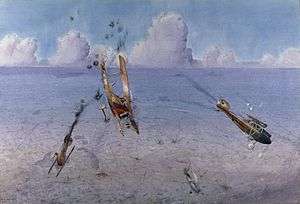Norman G. Arnold
| Norman G. Arnold | |
|---|---|
| Born |
19 September 1892 Leigh, Lancashire, United Kingdom |
| Died |
July 12, 1963 (aged 70) Harrow, Middlesex, United Kingdom |
| Other names | Norman Gregory Arnold |
| Occupation | Art director |
| Years active | 1922-1963 (film) |
Norman G. Arnold (September 19, 1892 – December 7, 1963) was a British art director who designed the sets for over a hundred and twenty films.
Early Life & WW1

Arnold studied architecture, interior decoration & design. During the First World War, Arnold served in the Royal Flying Corps with the rank of Lieutenant and worked in the Armaments School. In 1918, Arnold was appointed to be an official war artist, tasked with portraying types of aircraft, methods of aerial fighting and specific famous air battles on the Western Front. He produced a number of water-colour paintings which are now housed in the Imperial War Museum in London, including the 24 x 36 inch painting The Last Flight of Albert Ball VC. [1]
Film Career
Arnold entered the film industry in 1920 in the silent era. His first employer was Famous Players Lasky Corporation for which he was the art designer on eight films before he began working for British producer Herbert Wilcox in 1922, working on films in Berlin such as Decameron Nights in 1924. Between 1927 and 1946, Arnold served as an Art Director for a number of film companies including British Lion, First National and Independent Companies. By 1948, Arnold had been art director on over 150 feature films.[2] In the early 1940s, he was employed by Warner Brothers at Teddington Studios. In 1947 he designed the sets for Hue and Cry, the first of the Ealing Comedies.[3] His final work was on the Cold War thriller Ring of Spies, which was completed after his death.
His brother Wilfred Arnold was also an art director.
Selected filmography
- Chu-Chin Chow (1925)
- The Beggar Student (1931)
- That's My Wife (1933)
- The Stickpin (1933)
- Cleaning Up (1933)
- Great Stuff (1933)
- Passing Shadows (1934)
- On the Air (1934)
- Gay Love (1934)
- Marry the Girl (1935)
- Charing Cross Road (1935)
- Soft Lights and Sweet Music (1936)
- Calling All Stars (1937)
- Blondes for Danger (1938)
- The Return of the Frog (1938)
- What a Man! (1938)
- Hoots Mon! (1940)
- The Midas Touch (1940)
- The Prime Minister (1941)
- Atlantic Ferry (1941)
- Flying Fortress (1942)
- The Peterville Diamond (1942)
- They Met in the Dark (1943)
- Candlelight in Algeria (1944)
- Hue and Cry (1947)
- The White Unicorn (1947)
- Here Come the Huggetts (1948)
- Vote for Huggett (1949)
- Dance Hall (1950)
- Fun at St. Fanny's (1956)
- Account Rendered (1957)
- Ring of Spies (1964)
References
Bibliography
- Barr, Charles. Ealing Studios. University of California Press, 1998.